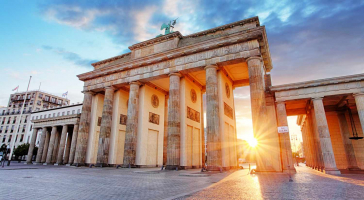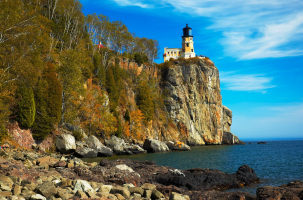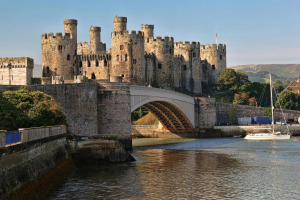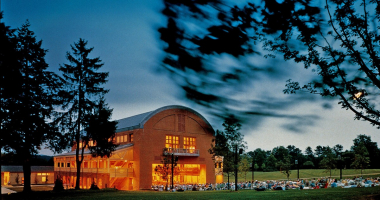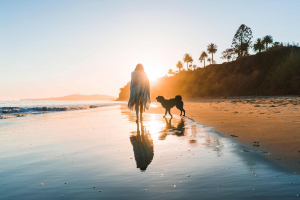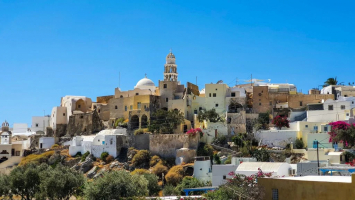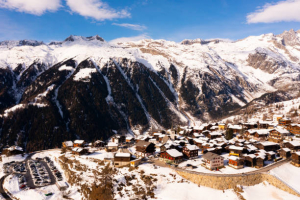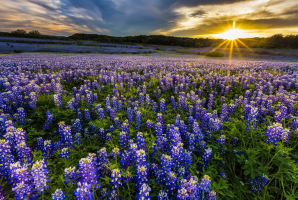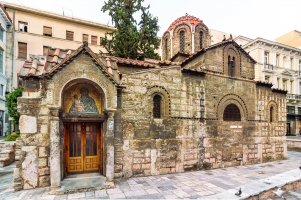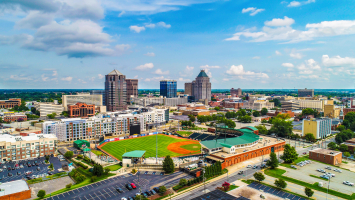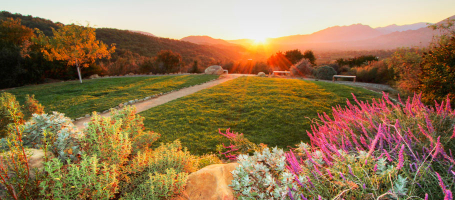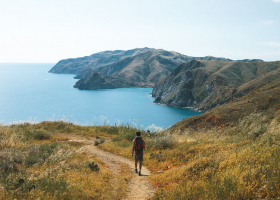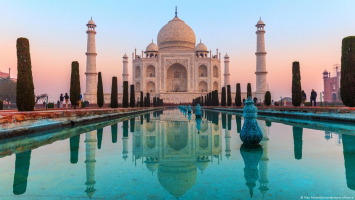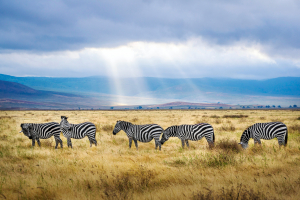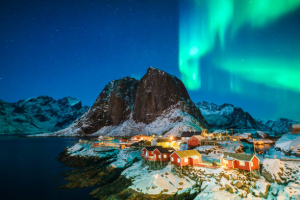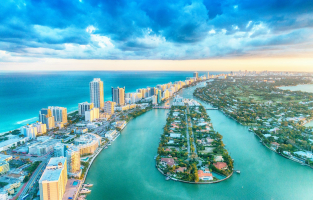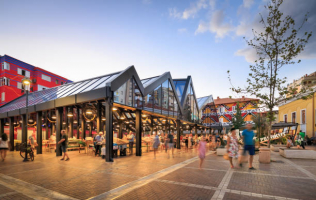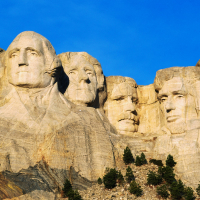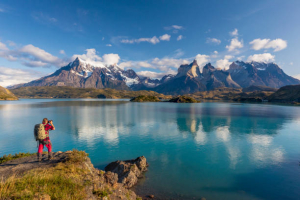Top 10 Best Things to Do in Peru
Peru is an adventure-lovers paradise. It’s well known as one of the most diverse countries in the world with beautiful beaches, tall mountains, lush jungles, ... read more...and delicious food! if you're planning to visit this beautiful country, take a look at this top 10 best things to do in Peru!
-
The Inca Trail to Machu Picchu is a winding footpath that climbs from the depths of the Urubamba Valley, through several types of Andean environments including cloud forest and alpine tundra, alongside the ruins of ancient way stations, and leads to the Sun Gate on Machu Picchu mountain. There are three trails that belong to the Inca Trail, which are: Mollepata, Classic, and One Day. The Mollepata trail is the longest and most famous trail out of the three trails.
The biggest reason for taking this trail is because of its final destination, Machu Picchu, which is one of the 7 Wonders of the World. Machu Picchu is believed to be built as an estate for the Inca emperor Pachacuti from 1438 to 1472, therefore, today it is often referred to as the "Lost City of the Incas". This city is abandoned at the time of the Spanish conquest, and nowadays, it is one of the most famous tourist spots in the world.
The Peruvian government has severely restricted the organizations that can offer guides and set a limit on the number of hikers allowed on this trail each season out of concern that excessive use will cause erosion. Booking in advance is therefore required. There is a daily limit of 500 people allowed on the trail, of whom only 200 are hikers and the remaining are porters and guides. Hikers who want to take this trail also need to note that people frequently experience altitude sickness while hiking the Inca Trail because of the height changes, especially if they haven't had much time to acclimate in Cusco.
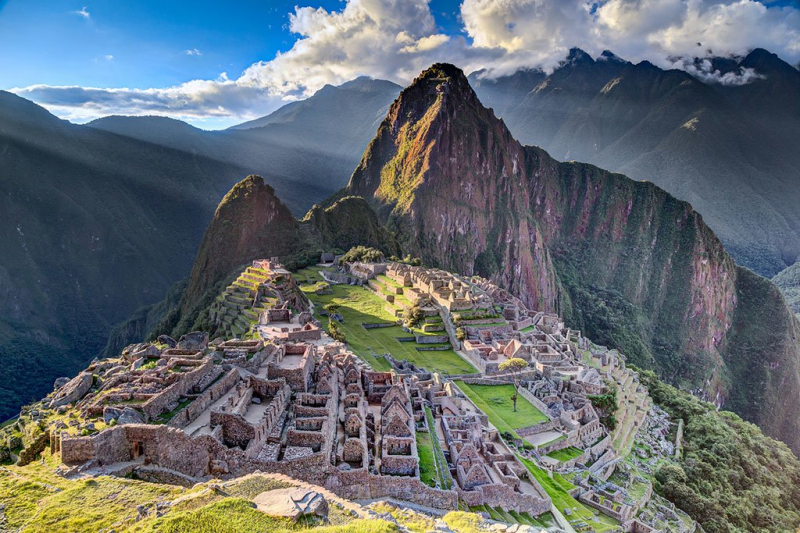
Photo: Kimkim Video: Alpaca Expeditions -
Besides the Inca Trail to Machu Picchu, the hike to and from Rainbow Mountain is of the best things to do in Peru, since Rainbow Mountain is another majestically beautiful place you can not miss in this country. Rainbow Mountain is also called Vinicunca, Winikunka, Montaña de Siete Colores, or Montaña de Colores by locals. It is a mountain in the Andes of Peru, located on the road to the Ausangate mountain, in the Cusco region, Canchis province, Peru with an altitude of 5,200 meters (17,100 ft) above sea level. The name of the Mountain came from a special phenomenon that happens on the mountain - due to its mineralogical composition on the slopes and summits, the mountain has a series of stripes of various colors, almost like a rainbow landing down on both sides of the mountain. Rainbow Mountain used to be covered by glacier caps, they melted 10,000 years ago due to climate change.
The hike to Rainbow Mountain is a day-long trek at over 14,000 feet, tracing a dirt path between looming peaks of green and startling red rock. the route is absolutely gorgeous, and you will also have a chance to pass local villages built from stone and glittering mountain streams before you reach the beautiful mountain. Even if you are not a fan of hiking, this seems to be the only way you can get to the mountain, since there are no robust methods of transportation to Vinicunca as of 2019.
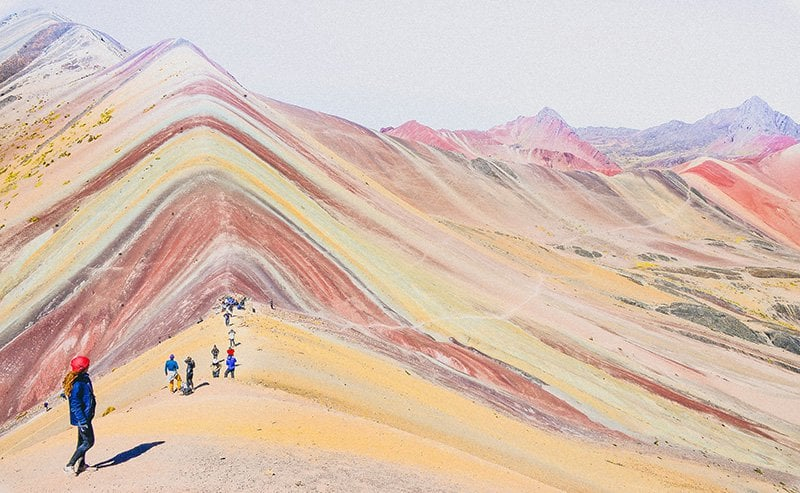
Photo: Wikipedia Video: Peru Summit Adventures -
Peru is home to one of the biggest deserts - occupying 188,700 square km, and most likely home to the highest dune in the world - the Cerro Blanco dune. The ever-changing nature of dunes makes them incredibly difficult to measure, but the Cerro Blanco dune is thought to be as high as 2,080 meters (6,824 feet). The dune is located in the arid Nazca region of Southwest Peru, between the Andes Mountains to the east and the Pacific Ocean to the west. It’s about 700 km (434 miles) west of Cusco, and 450 km (280 miles) south of Lima, Peru’s capital city.
People come to the dune mostly for hiking to the peak of Cerro Blanco. The typical trail that most hikers take is nine miles long, passing breathtaking canyons and wild desert scenery. Once you start hiking in the sand dunes, you’ll actually hike along the ancient Inca trail, before it finally disappears in the neverending sand dunes. It takes most hikers about three or four hours to reach the top of the dune. At the top of the dune, you'll be able to see the Nazca valley, and if the weather is clear enough, you can even see the Pacific Ocean.
Once you reach the top of the dune, you can take the same route to go back. However, many people who come here aren’t interested in walking down. Rather, they sandboard down the dune. If you’ve ever gone snowboarding, the experience is very similar. But with sandboards, you can sit or even lay down if you want to, providing an opportunity for anyone to give it a try. For most people, it takes much longer than four minutes to slide down the dune. This is for sure one of the most unique experiences one could have.
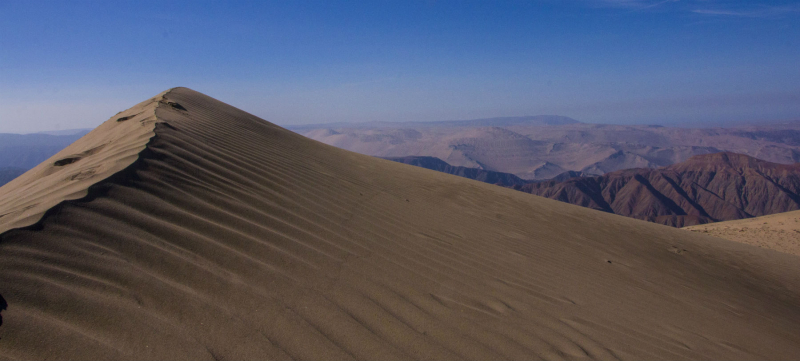
Photo: Ayni Peru Expedition Video: SurferToday -
Peru is also home to many good wines, and the country's national drink is worth trying once you are in Peru - Pisco. Pisco is one of the most exquisite liquors in the world. It is considered one of the finest liqueurs, containing between 42 and 52 degrees of alcohol. It is also used as a culinary ingredient in several dishes. The drink is a Peruvian grape spirit obtained from the distillation of fresh juice from the fermentation of the grapes, following traditional practices established in the production areas by the national legislation governing Pisco.
The Wine tour in Peru is the tour that will allow you to take place in the Vendimia Festival and try out this one-of-a-kind wine of Peru. The Vendimia Festival is the grape harvest festival held in March and is about 10 days long. Joining this festival, tourists will have a chance to learn about wine and pisco-making processes, and sample local vintages. Listening to Criollo music and watching Marinera dance competitions, firework displays, and parades are also interesting activities that tourists can take part in. This event has been an annual event in Peru for over 50 years, attracting both domestic and foreign tourists.
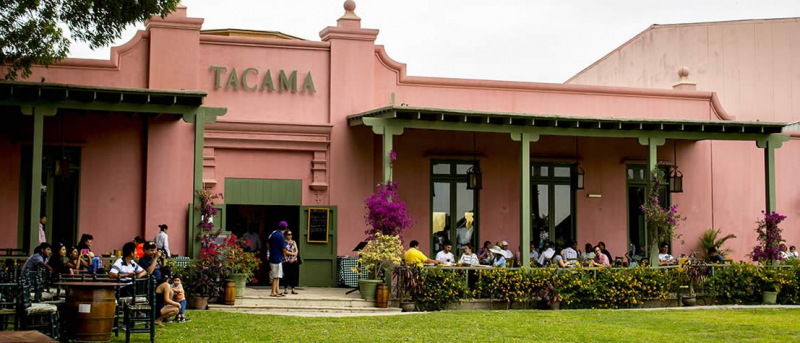
Photo: Extreme Tours Huacachina Video: Inkayni Peru Tours -
Another exciting to do in Peru that you just can not miss is visiting the Nazca Lines. The Nazca Lines are a group of enormous geoglyphs (designs or motifs etched into the ground) that are situated on the Peruvian coastal plain about 250 miles (400 kilometers) south of Lima, Peru. The 2,000-year-old Nazca Lines are thought to be created by the ancient Nazca culture in South America and were designated a UNESCO World Heritage Site in 1994. Despite being studied for over 80 years, the geoglyphs are still a mystery to researchers.
The Nazca Lines are perhaps best known for the representations of about 70 animals and plants, some of which measure up to 1,200 feet (370 meters) long. Examples include a spider, hummingbird, cactus plant, monkey, whale, llama, duck, flower, tree, lizard, and dog. There are also humanoid figure lines such as “The Astronaut”. Most of the known geoglyphs were formed by removing rocks from only the border of the figures, or by removing rocks from the interior. These impressive lines are also thought to be related to aliens or ancient astronauts. Given the low amount of rain, wind, and erosion, the geoglyphs have remained largely unscathed throughout the centuries, attracting many people from all around the world.
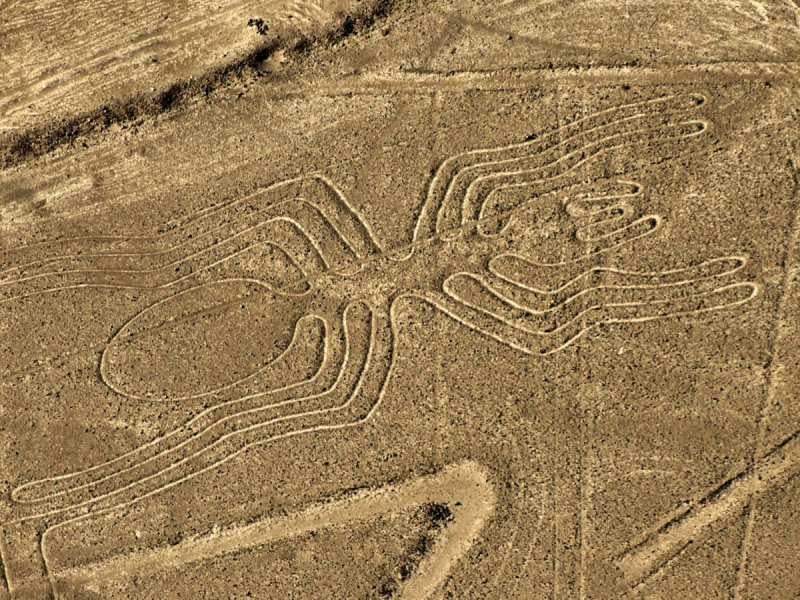
Photo: www.history.com Video: Discovery UK -
Besides the Vendimia Festival where you can taste Peru's finest wine, the Inti Raymi Festival is also a famous annually celebrated festival in Peru. It is one of the most important and traditional festivities celebrated in Peru. Dating from the Inca period, which is over 500 years before, the Inti Raymi Festival is a kaleidoscope of rituals and processions dedicated to Inti Raymi, the Sun King in the Inca belief. The festival is celebrated to beseech Inti Raymi to deliver a good harvest. The Inti Raymi Festival is usually held on 24 June. During the festival, locals dress up in elaborate costumes, dignitaries are paraded through the streets of Cusco in ornate carriages and there is lots of feasting and drinking in honor of Pachamama, which is Mother Earth in Inca belief.
The main ceremony of the Inti Raymi Festival takes place in the ruins of Sacsayhuaman. After a few rituals, including the speech at exactly 1:30 PM, a single llama is sacrificed to appease the sun and ensure that the days begin to get longer again. There are dances and performances that once more showcase the indigenous customs and cultures of the four regions of the former empire and its diverse populace. As the celebration comes to a close, everyone returns to Cusco's historic center for various after-parties and festivities.
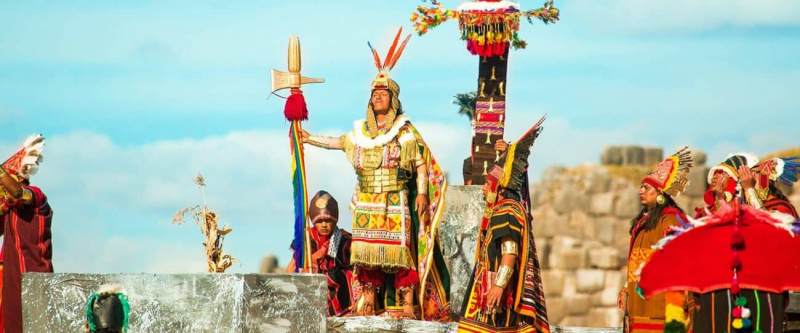
Photo: Peru Hop Video: alanxelmundo -
The Ballestas Islands are part of Peru Paracas National Reserve. It is a group of rocky islands located off the Pacific coast of Peru near the town of Paracas, 3 hours south of Lima. The islands' sandy beaches at La Mina and Mendieta are absolutely legendary. In there, people can also see the Paracas Candelabra geoglyph, a huge hillside etching, which still baffles archaeologists today.
However, the Ballestas Islands is mostly famous for its majestically beautiful sceneries with various wildlife that would make every animal lovers fall in love. The islands, despite being rough and rugged, are home to countless colonies of sea lions, penguins, and seabirds, such as albatrosses, boobies, and pelicans. Thousands of animals and birds find shelter in the natural arches and caves, and the waters offer them a plentiful supply of food. because of this diversity of animals, the islands were once the center of a lucrative guano trade. However, today, they are strictly protected. To go to the Ballestas Islands, you'll have to use one of the local wildlife boat tours, and you can only go to some designated parts of the islands. Moreover, you cannot swim with the animals or walk on the islands, but you can get very close to them on the boat tour.
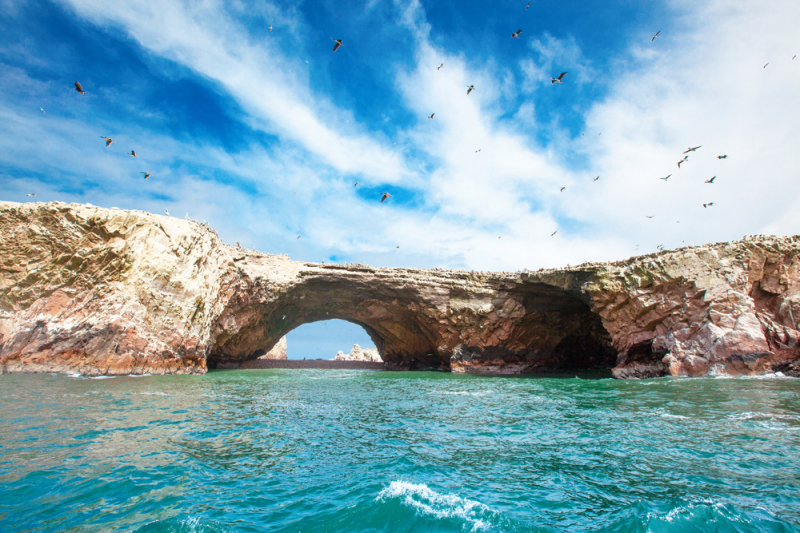
Photo: Chimu Adventures Video: Michael Grobman -
Lake Titicaca is a large freshwater lake in the Andes mountains on the border of Bolivia and Peru. It is believed to be the largest lake in South America by volume of water and by surface area, and the highest navigable lake in the world. The Inca people believed that the sun is birthed in this very lake, and therefore it has been a very important place for the people in Peru. Because of its beauty, travelers to Peru often rate it as the highlight of their visit.
The lake is well known for its man-made islands built of totora reeds and for supplying local Uros Indians with floating homes. Additionally, reeds are made into houses, boats, and even crude toys to entertain children. Puno is the ideal starting point for exploring the islands since you can walk on their unnervingly bouncy surface and observe the long-standing customs of the locals firsthand.
To go to lake Titicaca, consider taking the most beautiful train journey in Peru - the Titicaca train over the Andean altiplano between Cusco and Lake Titicaca. Taking this train, you will be able to have a wide-screen view of landscapes, llama-dotted plains, and valleys dotted with Adobe villages. The best part of the train journey is being able to see the Sunset surrounded by the lake’s gleaming waters.
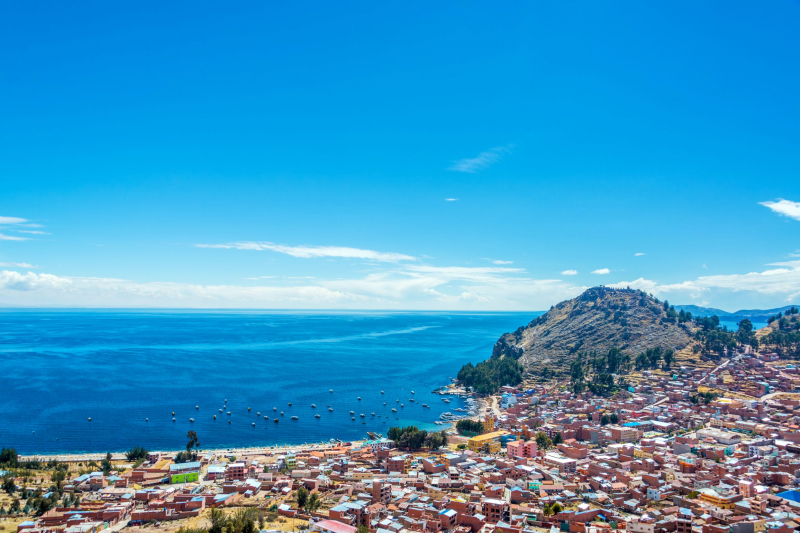
Lake Titicaca - Lonely Planet Video: unowho travel channel -
What's more exciting than seeing with your own eyes the green lung of the Earth? The Amazon Basin is long known for its intense biodiversity and riotous rainforest wilderness. Its vastness and impenetrability have long protected its indigenous communities and diverse wildlife from external eyes. Tribes exist here that have never had contact with outside civilization, and more flora and fauna flourish in one rainforest hectare than in any European country.
Taking a kayak tour through the Amazon rainforest, you will be able to see a stunning variety of tropical wildlife that nowhere else in the world has. The kayak tour will take you through the well-preserved national park here, and at Cocha Salvador, one of the park's largest and most beautiful lakes, you'll find camping and guided hiking possibilities, as well as wonderful wildlife viewing. During the tour, you can see scores of different bird species, several kinds of monkeys, and a few other mammals on both sides of the river. If you are lucky, you can even see local residents that live secretly in the jungles.
If you're thinking about taking the kayak tour, remember that there are more opportunities to kayak down minor rivers during the high water season (December to May), whereas hiking through the jungle is best during the low water season (June to November).
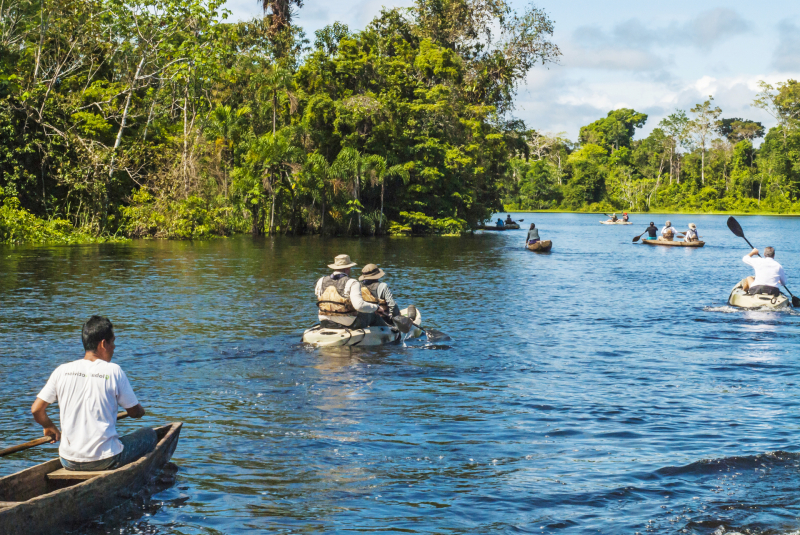
Photo: Aqua Expeditions Video: Drink Tea & Travel -
Peru is truly a paradise for travelers since this place offers all kinds of terrains, including deserts, mountains, rainforests, and beaches. The beaches in this country also offer one of the most incredible activities on the northern coast of Peru, which is whale watching. Every year, between August to October, the whales migrate from the cold waters of the Antarctic to the warm waters of the north of Peru to reproduce or give birth to their young. It is estimated that up to 2,000 whales arrive per season at the beaches of Órganos, Cabo Blanco, and Punta Sal.
During the whale's mating period, you can go on a boat and reasonably expect to see some whales up close. If you are lucky, you will see them very closely, from the same coast or beaches. However, It is thought to be best if you take a tour on a big yacht since the giant animal can break your boat very easily. Usually, these tours offer the assistance of a qualified guide (Biologist), sonars that allow you to listen to the song of the whales, and other security implements. Watching the biggest mammals on earth with docile and harmonious movements from a close distant will for sure make an amazing experience for tourists from all over the world.
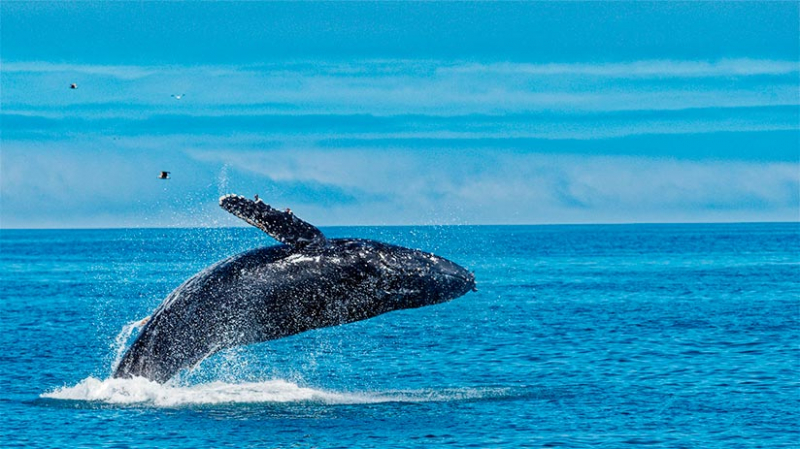
Photo: machutravelperu.com Video: Mark Scheppert












